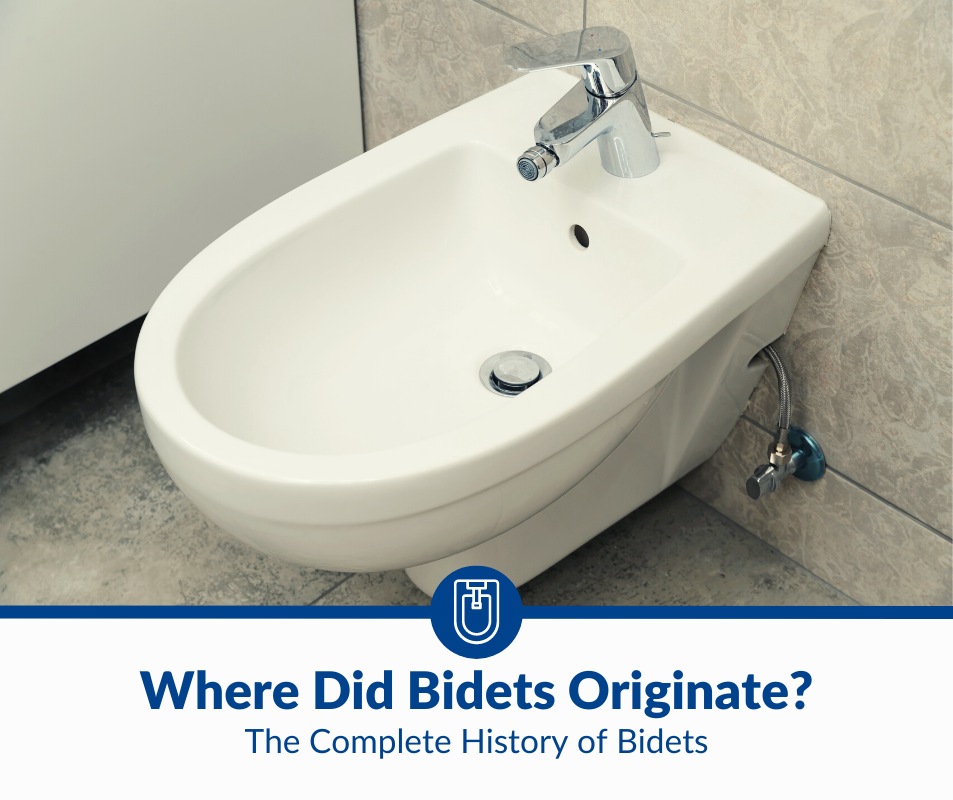Where Did Bidets Originate?: Complete History of Bidets
What most people refer to as bidets nowadays is a washlet or a toilet with a bidet attachment, seat, or handheld sprayer. The original bidet wasn’t attached to or on a toilet. The first bidet was a separate or standalone basin or bowl in a bathroom, boudoir, chamber, privy, or water closet.
Modern bidets as toilet attachments originated in the US in the 20th century. The bidet as a standalone basin or bowl originated in 18th-century France. But the very first bidet may have preceded those we know by decades, if not centuries, especially in France and Italy.
There isn’t sufficient historical evidence to definitively conclude that the early modern era bidets originated in one place or were designed by a particular person. Like all essentials, bidets may have multiple origins, sequentially or simultaneously. Read on to know the history of bidets.
Where Did Bidets Originate
Bidets have two distinct origin stories because the classic and modern avatars are not identical or even similar, albeit all the versions have had the same purpose. Also, the two tales share the same historical and technological evolution.
Let me first highlight the seminal developments related to the classic or original bidet.
The Origin of the Bidet in the Early Modern Era
There’s a consensus that Christopher Des Rosiers, also spelled as DesRosiers, Desrosiers, and des Rosiers, created the bidet that is evidentially the first or the original sanitation furniture of its kind.
However, this historical proof is more specifically about a royal bidet and its growing popularity since the time of King Louis XIV, the longest-reigning monarch of France, and among all reigns in Europe as well as the world.
Christopher Des Rosiers was a furniture maker who served the royal palace, among others. In the first decade of the 1700s, Des Rosiers designed and made a type of sanitation device or tool. The furniture comprised a porcelain bowl mounted on a wooden platform with legs.
The ceramic bowl wasn’t exactly round. It was more like an elongated or oval basin. The bowl was mounted on a wooden platform with legs or stands, which were made of mahogany. The French had abundant mahogany exported from its Caribbean colonies at the time of Louis XIV.
There isn’t a specific date documented to mark the creation or delivery of the royal bidet made by Christopher Des Rosiers. The years cited by historians vary from 1705 to 1710, the latter being a publication when the term ‘bidet’ was first used in the context of sanitation furniture.
Thus, it is fair to consider the possibility that bidets were already in use prior to the special one created for King Louis XIV. There were also different versions of a basin or bowl for bathing and cleaning purposes across civilizations until the early modern era, including the following periods:
- Bronze Age
- Iron Age
- Classical
- Medieval
That said, bidets used by King Louis XIV, others in the palace, and French aristocrats were the first widespread adoption of such a sanitation device in a culture or society. This original bidet popularized in France had many immediate successors, including a famous one.
The Portable Silver-Gilt Bidet of Napoleon Bonaparte
Among the reasons for the popularity of bidets in 18th-century France was the prevailing belief that bathing or washing was unhealthy due to contaminants spread through water. King Louis XIV was known for not having baths, so the bidet became essential to his sanitary hygiene.
Many people, regardless of gender and including aristocrats and members of the royal families, didn’t have regular baths or showers at the time. Naturally, bidets became a useful way to wash and clean one’s anterior and posterior. The bidet became more popular and prevalent over time.
A documented piece of evidence other than the first publication about a bidet referring to King Louis XIV serves as the source to establish the historical origin and proof of the popularity of bidets in France in the 1700s. That proof is Napoleon Bonaparte’s last will or testament.
Napoleon Bonaparte’s testament or last will had an inventory of all his possessions, especially what he used. The long list included a silver-gilt bidet, among the following:
- Alarm clock of Frederic II
- French telescope
- Furnished silver dressing-case
- Gold clock, watches, seals, etc.
- Iron bedsteads, mattresses, etc.
- Mahogany boxes
- Silver-gilt perfuming pan
- Silver decanters
- Wash handstand
- Water jug
Napoleon Bonaparte always traveled with his portable bidet, irrespective of the destination or the purpose of his journey. Also, the same inventory in his last will listed all his wearables, so it is fair to conclude that the silver-gilt bidet was as crucial to his daily life as these essentials:
- All-in-one vests
- Batiste sheets
- Belts
- Braces
- Coats
- Collars
- Cravates
- Dressing gowns
- Flannel waistcoats
- Gaiters
- Handkerchiefs
- Hats
- Linen shirts
- Night trousers
- Pillowcases
- Shoes
- Silk stockings
- Slippers
- Socks
- Towels
The choice or use of silver for Napoleon’s bidet isn’t surprising because the metal is known for its antimicrobial properties. Additionally, there is evidence of Napoleon Bonaparte’s silversmith and goldsmith making bidets, among other artifacts and furniture.
Martin Guillaume Biennais is believed to have made the silver-gilt bidet used by Napoleon, as he had also designed and engraved similar furniture, and various types of ornate creations in his lifetime. Therefore, the French origin and timeline of the first bidets are mostly undisputed.
French Origin vs. Italian Passion for Standalone Bidets
Bidets weren’t popular only in 18th-century France and thereafter. Traditional bidets were and are common in Italy. These classic bidets aren’t the attachments you may be familiar with in the US. Italians continue to use the freestanding or standalone bidets installed next to their toilets.
Generally, Italians use toilet paper before washing their posterior in a conventional bidet. Most Italians using the classic bidet are passionate about it. But there isn’t any historical proof that establishes Italy as the place of origin for the first-ever bidet in the world.
The historical evidence of King Louis XIV and Napoleon Bonaparte’s bidets and the French aristocracy popularizing the hygiene or sanitary apparatus don’t have a counter in the form of a primary, similar, or verifiable source of such furniture being created or used earlier in Italy.
However, like everything from fire to plumbing or the first bathtubs, it is quite possible that bidets were used in France and Italy before the documented evidence at the court of King Louis XIV or in the will of Napoleon I. Such contentions are common for many creations throughout history.
Historical Evolutions Until the Medieval Era and Bidets
The first bidet didn’t evolve out of nothing. Various types of sinks, tubs, and washbasins, along with other creations or inventions, paved the way for the first bidet in France. Hence, one can’t rule out the possibility that one or more versions of the bidet or its kind existed elsewhere.
Ancient Bathtubs
The first public bath dates back to Ancient India in the 3rd millennium BCE. The Indus Valley Civilization spanning Harappa (India) to Mohenjo Daro (present-day Pakistan) also developed the first planned township with plumbing systems using copper pipes and citywide drainage.
Plumbing systems predated the smaller private bathtubs that have been found in most ancient civilizations, including the following:
- Ancient Egypt
- Ancient Greece
- Mesopotamia
While the Indians made copper pipes for plumbing, the ancient Greeks of Crete and Minoans used terracotta. One of the oldest bathtubs in the world in a relatively preserved condition was found in Crete. This terracotta bathtub is from the 2nd millennium BCE.
Small private bathtubs were used by many subsequent civilizations until the early modern era when the French created an even smaller version. But the bidet wasn’t the first smaller version of private bathtubs. A miniature variant predates the bidet by thousands of years.
Chamber Pots
Like bathtubs, chamber pots were independently developed by many ancient civilizations that had no contemporary links or even proximity. The history of toilets is also similar. Cesspits have been around for around 5,000 years. Long drop toilets or pit latrines are equally ancient as well.
Small chamber pots or ceramic kettles were used by all of the major civilizations. If you compare the original bidet to chamber pots, the two aren’t very different conceptually, albeit the intended purposes were distinct. Chamber pots were smaller and without a seat with stands, of course.
That said, ceramic kettles or chamber pots were immensely popular in 18th-century France. The oval-shaped porcelain bowl, known as the Bourdaloue in French, was smaller than a bidet, and it wasn’t intended for cleaning or washing. But both were popular during the same time period.
So, does the ceramic kettle or chamber pot immediately precede the first bidet in France? Think about the reason why such chamber pots were called Bourdaloue. They were named after the French Jesuit priest Louis Bourdaloue.
Regarded as the greatest religious preacher of the 17th century, Louis Bourdaloue would deliver long sermons. Hence, the attendees used small chamber pots so that they didn’t have to leave the court in the midst of a session. Also, Louis Bourdaloue himself may have used these pots.
Since these chamber pots were used during the lifetime of Louis Bourdaloue, they must have been prevalent much before 1704, when he died. The first documented bidet of King Louis XIV was made after Bourdaloues were already popular in France. So, did other bidets also exist?
Multipurpose Basins
The earliest bidets or similar bowls weren’t only used for sanitation. French soldiers had the practice of using portable basins filled with water after long and strenuous horse riding to soothe their sore buttocks. Likewise, small basins were also used to clean and wash feet.
The word bidet incidentally means pony, which is a direct reference to how one would sit on it to use the furniture. The word may also refer to the fact that French soldiers would use the bidet in a posture similar to how they sat on their horses. Only the bidet was much smaller, so a pony.
Therefore, it is presently impossible to infer with certainty whether the bidet of Louis XIV was indeed the first one of its kind or merely a derivative of the chamber pots or multipurpose basins that existed already. It is quite probable that some bidets were in use before the royal version.
The Origin of Modern Bidets Through the 1900s
Unlike the early modern era bidets, the contemporary versions have a traceable and verifiable origin story. Arnold Lewis Cohen designed the modern bidet as a toilet attachment and applied for a patent in 1972.
Sani Seat Inc. filed the patent application on 7/10/1972. The patent application was granted on 5/14/1974. The hygienic apparatus patent US3810260A was subsequently assigned to Arnold Lewis Cohen’s American Bidet Company. But the patent has since expired.
Here are the key features of the bidet attachment as a hygienic apparatus, as initially claimed and described by Arnold Lewis Cohen:
- The hygienic apparatus is to be used on a toilet bowl with a seat.
- The housing comprises a water container and dispensing element.
- The dispenser uses a motorized impeller assembly for a water jet.
- The design includes a mounting plate with hinges for the toilet bowl.
- The dispenser assembly uses a valve to regulate the flow of water.
- The water container in the housing is removable but an essential part.
- The dispensing element uses a discharge nozzle under the toilet seat.
- The hygienic apparatus uses contemporary, standard flushable toilets.
Cohen’s hygienic apparatus isn’t the only modern bidet, of course. The classic bidet is still around, especially in Europe. The earliest French and Italian bidets have evolved to include flushing mechanisms, but these versions continue to be standalone fixtures next to toilets.
Flushable Toilets Are the Foundation of Modern Bidets
Whether it is Cohen’s bidet attachment or freestanding sanitation fixtures next to toilets, both variants are possible due to modern flushing systems. However, unlike Cohen, there is no evidence proving that any individual came up with the first flushable standalone bidet.
The invention and subsequent modifications of flushing technologies have historical records, such as the first flush toilet made by Sir John Harrington. The godson of Queen Elizabeth I created a water closet in 1592, comprising an elevated cistern with a small downpipe.
Sir Harrington even installed a flush toilet for the queen, but he didn’t describe or reveal his invention to the public until a few years later when he published his book, The Metamorphosis of Ajax, in 1596.
A Scottish inventor and watchmaker, Alexander Cumming, was the first to own a patent for a flushable toilet in 1775. In 1778, Joseph Bramah patented his flushing technology, which was an improvised version of Cumming’s mechanism. Bramah used hinged valves.
Despite the inventions, flushing toilets didn’t become popular until the late 19th century. Thomas Crapper, an English business owner and plumber, is credited with popularizing flush toilets. But Crapper didn’t invent any flushing mechanism. He promoted the technology and modified it.
It is fair to conclude that with the advent of flushable toilets or flushing mechanisms, bidets soon got to feature a flush system in France, Italy, and elsewhere. However, there is no single creator or group credited with such a tectonic transformation for bidets.
The Evolution of Modern Bidets As Toilet Attachments
Unlike the flushable standalone bidet, toilet attachments or washlets have a well-documented origin story and subsequent evolution. While Arnold Cohen designed the first modern bidet in the 1960s for his father, and his company had the patent in 1974, his creation wasn’t a success.
There were few to no takers of the bidet in the US. According to Cohen, advertising and talking about tushy washing was a non-starter for Americans, so he licensed the rights to manufacture bidets to a Japanese company called Toto. Even today, Toto is synonymous with bidets.
Toto Ltd. improvised Cohen’s concept and launched its own version of a luxury bidet in 1980. It was branded and trademarked as Washlet. The company had sold over 40 million Washlets by 2015. And ~81% of Japanese households had electronic toilets with bidet features in 2018.
Unlike Japan and the Middle East in Asia or France and Italy in Europe, the bidet was almost nonexistent in the US until recently. While many companies have been making bidets in the US, the adoption of such toilet attachments received a boost only during the coronavirus pandemic.
The shortage of toilet paper was one reason, and the other was probably an alarming concern about personal hygiene and sanitation. Today, many companies manufacture and sell bidets in the US, including but not limited to the following:
- Brondell
- Inax
- Kohler
- Toto
- Tushy
Like the Toto Washlet, many bidets nowadays are luxury attachments with fancy features. You can now look for the following attributes in bidet seats and attachments for toilets:
- Cool and warm water jet streams for cleaning
- Dual nozzle for anterior and posterior washing
- Heated seat, slow closing, telescoping, etc.
- Multiple spraying patterns for different needs
- Nozzle or sprayer adjuster to realign the jet
- Pressure and temperature regulator controls
- Warm air dryer, deodorizer, self-cleaning, etc.
Luxury bidets are also getting smarter with safety features and sensors. For example, the Toto Washlet has an automated lid that uses a proximity sensor to close and open.
Final Thoughts
The only bidet attachment I haven’t discussed is the handheld sprayer because it isn’t a distinct invention, and hence there is no special origin story. The handheld sprayer is simply a version of the hand shower that was first designed and made by Hans Grohe in the early 20th century.







